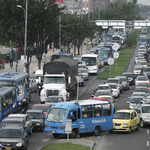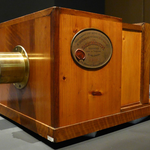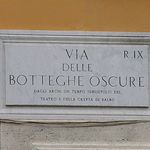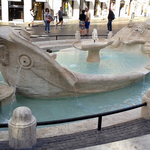EUR
The International Exposition of 1942 is appeared in 1937 with the name of E42. It became an excuse of the Fascist regime for to create a whole monumental town of new Imperial Rome in the south of the city. The area was chosen with the intention
to orientate the city development towards the sea arranging it around the satellite center.
It gave a start to the foreseen future expansions of the great dream to bring Rome to the Mare Nostrum.
The transport link to the historical center of the city is provided by the metro and by the big arteries like the via Cristoforo Colombo that crosses the EUR as its back-bone.
This street together with Via dei Fori Imperiali and the street of Terme di Caracalla connects Rome Piazza Navona to the Lido di Roma.
The surrounding buildings constructed with the intention of monumentality and the characteristics of the stability should have constituted together with the road net and with the establishment of the public services the base for the realization of the exposition. The construction of it was entrusted to the group of architects and town-planners directed by Marcello Piacentini who initiated the works in 1938.
After the beginning of the war the works were suspended, the buildings partly constructed were damaged by the military occupations of Germany and the allies. The area untill 1950 remained a dead town where the uncoltivated vegetation didn't conceal the dreariness of the deserted and partly constructed buildings.
In 1951 the government established the E.U.R corporation, that meant the autonomous universal exposition of Rome that in some way should have taken some decisions about the future of the area.
The taken decision was not to demolish and destroy what was already existed. The works were started again but with a new direction. The "imperial" palaces of megalomaniac memory shouldn't be completed and restructured but attenuated and adjusted to the new environment, a new EUR quarter.
The new buildings were added to the first ones. The directional area was established here and important headquarters of the institutes and the public offices were transferred here into the area. All this in its architectural appearance, realized by the architect Guido Marinucci matches very well to the new quarter being very residential because of villas and the parks.
In the occasion of the Olimpyc games of 1960 a new impulse was given to the EUR area with the creation of new sports establishments like the Palace of Sports, the artificial lake, the swimming pool of the roses, the Olympic cycling track.
The EUR rises up in the district of 430 hectares fairly urbanized between roads, squares and car parkings which occupy 28% of the area, 25% is destined to the green zone while only 41% of the surface is occupied by the buildings, 22% of which are private residences and 19% are public buildings.
The emblem of the EUR is the Palace of the work Civilization, so-called the Colloseum square because it reminds the classical prototype which inspired the artists Guerrini, Padula and Romano. It has a square plan on a massive basement, 6 orders of 9 arcades for each side of totally 216 arches and 68 meters of the height. Four groups of statues of Morbiducci and Felci have four corners. On the opposite side there is the Palace of the Congresses built by the project of Alberto Libera.
In the center of the Piazza Marconi there is the "Stele" of 45 meters dedicated to Guglielmo and sculptured by Arturo Dazzi realized with colossal carrara marble blocks engraved in the high-relief and superimposed.
Lots of the artists and architects Bacigalupo, Brusa, Castellani, Dazzi, De Pero, Felci, Ferri, Gercini Griselli, Guerini, Cancellotti, De Vico, Padula, Piacentini, Mattioni, Minnucci, Montuori, Morbiducci, Muratori, Nervi, Paniconi, Pediconi,Prampolini, Ortensi, Ortensi, Ratti, Romano, Rosso, Severini, Scarpelli, Vitellozzi participated in the construction of many modern buildings in the EUR such as INPS, INA, Palazzo Italia, Palazzo della Civiltà del Lavoro, four buildings on the Piazzale Marconi,
Palazzo dei Congressi, Palazzo Uffici, Museo della Civiltà Romana, Archivio di Stato e Direzione Generale Aereonautica, the church of St.Peter and Paul, Palazzo dello Sport, Ministeri delle Finanze, delle Poste, della Marina Mercantile, della Sanità, del Commercio con l'Estero,the church of Saint Pietro and Paolo, Palace Of the Sport, The Finance Ministries, the Post office, the Ministry of the Marine trade, the Ministry of the Public Health, of the Foreign Trade and some others.

 The records of Rome. Big numbers, not always enviable, for a big city.
The records of Rome. Big numbers, not always enviable, for a big city. New Phot-O-Matic section. To spend some time looking at photos (also) of Rome.
New Phot-O-Matic section. To spend some time looking at photos (also) of Rome. The administrative, urban, toponymic and imaginative subdivisions of Rome.
The administrative, urban, toponymic and imaginative subdivisions of Rome. Notice for tourists: in Rome you drink for free. Historical fountains and 'big noses'.
Notice for tourists: in Rome you drink for free. Historical fountains and 'big noses'. Free museums return on the first Sunday of the month.
Free museums return on the first Sunday of the month.